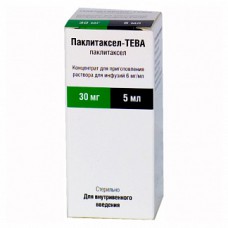Expiration date: 11/2026
Composition and form of issue:
Concentrate for solution preparation for infusions 6 mg / ml, 1 ml contains:
paclitaxel 6 mg
excipients: macrogol glycerylricinyloleate, citric acid anhydrous, absolute ethanol
in bottles of 5, 16, 7, 25 or 50 ml in a pack of cardboard 1 bottle.
Description of dosage form:
Transparent, colorless or slightly yellowish viscous solution.
Pharmacokinetics:
When/in the introduction for 3 hours at a dose of 135 mg / m2 Cmax is 2170 ng/ml, AUC — 7952 ng/h/ml with the same dose for 24 h — 195 ng/ml and 6300 ng/h / ml, respectively. Cmax and AUC dose-dependent: at 3-hour infusion dose increase to 175 mg / m2 leads to an increase in these parameters by 68 and 89%, and at 24-hour — by 87 and 26%, respectively.
Plasma protein binding-88-98%. Time poluraspredelenia from the blood into the tissues — 30 min Easily penetrates and absorbed by the tissues and accumulates mainly in the liver, spleen, pancreas, stomach, intestines, heart, muscles.
It is metabolized in the liver by hydroxylation with cytochrome P450 CYP2D8 isoenzymes (with the formation of metabolite-6-alpha-hydroxypaclitaxel) and CYP3CA4 (with the formation of metabolites of 3-para-hydroxypaclitaxel and 6-alpha-3-para-dihydroxypaclitaxel). It is excreted mainly with bile-90%. When repeated infusions do not cumulate.
T1/2 and total clearance are variable and depend on the dose and duration of/in the introduction: 13, 1-52, 7 h and 12, 2-23, 8 l/h / m2, respectively. After I / infusion (1-24 h) total excretion by the kidneys is 1, 3-12, 6% of the dose (15-275 mg/m2), indicating the presence of intense extra-renal clearance.
Description of pharmacological action:
Paclitaxel-Teva (paclitaxel) is an anti-tumor drug of plant origin, obtained by semi-synthetic means from the plant Taxus Baccata. The mechanism of action is associated with the ability to stimulate the Assembly of microtubules from dimeric molecules of tubulin, to stabilize their structure and inhibit dynamic reorganization in the interphase, which violates the mitotic function of the cell.
Indications:
- ovarian cancer (therapy of the first line of patients with a common form of disease or residual tumor (more than 1 cm) after surgery (in combination with cisplatin) and second-line therapy for metastases after standard therapy, which did not give a positive result)
- breast cancer (presence of affected lymph nodes after standard combination therapy (adjuvant treatment) after relapse of the disease, within 6 months after the beginning of adjuvant therapy — first-line therapy metastatic breast cancer (after ineffective standard therapy-second-line therapy)
- non-small cell lung cancer (therapy of the first line of patients who are not planned for surgical treatment and / or radiation therapy (in combination with cisplatin)
- Kaposi's sarcoma in AIDS patients (second line therapy).
Contraindications:
- hypersensitivity to paclitaxel or other components of the drug (including polyoxyethylated castor oil)
- the initial neutrophil content is less than 1500 / µl in patients with solid tumors
- initial (or recorded during treatment) neutrophil content of less than 1000 / µl in patients with Kaposi's sarcoma in AIDS patients
- pregnancy
- lactation
- child age (safety and efficacy not established).
With caution: inhibition of bone marrow hematopoiesis (including after chemotherapy or radiation therapy), liver failure, acute infectious diseases (including shingles, chickenpox, herpes), severe ischemic heart disease, myocardial infarction (history), arrhythmia.
Side effect:
The following adverse events noted in the application of the drug are distributed according to the frequency of occurrence in accordance with the following gradation: very often ( > , 1/10), often (from>, 1/100 to <,1 10="">,1/1000 before <,1 100="">,1/10000 before <,1 1000="" 1="" 10000="" p=">",
From the hematopoietic organs: very often — pronounced neutropenia, severe leukopenia, thrombocytopenia, anemia often-febrile neutropenia sometimes-severe anemia very rarely-acute myeloblastic leukemia, myelodysplastic syndrome. Inhibition of bone marrow function, mainly granulocytic germ, was the main toxic effect limiting the dose of the drug. The maximum decrease in the level of neutrophils is commonly observed in 8-11-day, normalization occurs on the 22nd day.
From the immune system: very often — hypersensitivity reactions, manifested mainly by skin rashes and tides of blood to the face sometimes — delayed hypersensitivity, pronounced hypersensitivity reactions that require additional treatment (for example, lowering blood PRESSURE, angioedema, respiratory distress syndrome, generalized urticaria) rarely-anaphylactic reactions very rarely — anaphylactic shock, including fatal cases. Described isolated cases of chills and back pain.
From the nervous system: very often — peripheral neuropathy (mainly paresthesia), drowsiness often — severe neuropathy (mainly peripheral), dizziness, increased excitability, insomnia, impaired thinking, depression, hypokinesia, gait disturbance, hypesthesia, taste change, headache rarely-peripheral motor neuropathy (leading to distal weakness) very rarely — grand mal seizures, ataxia, acute encephalopathy, confusion, optic nerve damage, autonomic neuropathy, manifested by paralytic intestinal obstruction and orthostatic hypotension.
On the part of the senses: often-ringing in the ears sometimes: dry eyes, amblyopia, visual field defects are very rare-visual disorders (shimmering scotoma) — in particular in patients receiving doses exceeding the recommended — reduction of visual acuity, conjunctivitis, increased lacrimation, hearing loss by neurosensory type, vertigo.
From the cardiovascular system: very often — decrease in blood PRESSURE, often-tachycardia, palpitations, bradycardia, fainting, vasodilation (tides) sometimes — cardiomyopathy, asymptomatic ventricular tachycardia, ventricular bigeminia, AV blockade, myocardial infarction, thrombophlebitis, increased blood PRESSURE, thrombosis of venous vessels rarely — rhythm disturbance, changes in the ECG is very rare — shock.
From the respiratory system: often — shortness of breath, nosebleeds rarely — interstitial pneumonia, pulmonary fibrosis very rarely-cough, pulmonary hypertension, pulmonary embolism, as well as more frequent development of radiation pneumonitis in patients, simultaneously undergoing radiation therapy.
From the digestive system: very often — nausea, vomiting, diarrhea, mucositis, constipation, stomatitis, abdominal pain often — dry mouth, ulceration of the oral mucosa, melanoma, dyspepsia very rarely — anorexia, acute pancreatitis, esophagitis, ascites there are isolated reports of acute intestinal obstruction, intestinal perforation, thrombosis of the mesenteric artery, ischemic colitis increase in liver activity transaminases (more often — act), schf and bilirubin in serum. Cases of hepatonecrosis and hepatic encephalopathy are described.
On the part of the skin and skin appendages: very often — alopecia often-reversible changes in the skin, dry skin, exfoliative dermatitis, psoriasis, rash, acne, moderate violations of the nail plate sometimes — pigmentation or discoloration of the nail bed rarely — erythema very rarely — multiform exudative erythema, including Stevens-Johnson syndrome, toxic epidermal necrolysis, urticaria, onycholysis.
From the musculoskeletal system: very often —arthralgia or myalgia often — bone pain, cramps in the legs, myasthenia gravis, back pain.
Local reactions: often-moderately expressed phenomena at the injection site (pain, swelling, erythema, induration and pigmentation of the skin extravasation can cause inflammation and necrosis of the subcutaneous tissue).
Other: very often — asthenia, swelling (including peripheral and swelling of the face), reduced tolerance to infections (any etiology) often — flu — like syndrome, malaise, chest pain, chills, fever sometimes-dehydration, decrease or increase in body weight, severe infections, septic shock.
Drug interaction:
Cisplatin reduces the overall clearance of paclitaxel by 20%, whereby more pronounced myelosuppression is observed in the case when paclitaxel is administered after cisplatin. Simultaneous administration with cimetidine, ranitidine, dexamethasone or diphenhydramine does not affect the binding of paclitaxel with plasma proteins. Inhibitors of microsomal oxidation (including ketoconazole, cimetidine, verapamil, diazepam, quinidine, cyclosporine, etc.) suppress the metabolism of paclitaxel.
Polyoxyethylated castor oil, which is part of paclitaxel, can cause the extraction of degf [di - (2-ethylhexyl) phthalate] from plasticized PVC containers, and the degree of leaching of degf increases with increasing concentration of the solution and over time.
Dosage and administration:
To prevent severe hypersensitivity reactions, all patients should be sedated using GCS, antihistamines and H2-histamine receptor antagonists. The recommended mode of premedication is 20 mg of dexamethasone (or its equivalent) inside, approximately 12 and 6 hours before administration of the drug Paclitaxel-Teva, 50 mg of diphenhydramine (or its equivalent) in/and 300 mg of cimetidine or 50 mg of ranitidine in/in 30-60 minutes before administration of the drug Paclitaxel-Teva.
When choosing the mode and doses in each individual case should be guided by the data of the literature.
Paclitaxel-Teva is administered in/in a 3-hour or 24-hour infusion at a dose of 175 or 135 mg / m2, respectively, with an interval between injections of 3 weeks. The drug is used as monotherapy or in combination with cisplatin (ovarian cancer and non-small cell lung cancer) or doxorubicin (breast cancer). The recommended dose of Paclitaxel-Teva for the treatment of Kaposi's sarcoma in AIDS patients is 100 mg / m2 in the form of a 3-hour infusion every 2 weeks. The administration of Paclitaxel-Teva should not be repeated until the neutrophil content is at least 1500/µl of blood, and the platelet content is at least 100000/µl of blood. Patients who after the administration of Paclitaxel-TeV observed pronounced neutropenia (neutrophil content <,500 7="" -="" 20="" p=">",
Rules of preparation of solution for infusion
Solution for infusion prepared immediately prior to administration by diluting the concentrate of 0, 9% sodium chloride solution or 5% dextrose solution or 5% dextrose solution in 0, 9% solution of sodium chloride for injection or 5% dextrose in ringer's solution to final concentrations of 0, 3 to 1, 2 mg/ml. the Prepared solutions can opalestiruty due to the presence in the composition of the dosage form the foundations of the carrier, and after filtration opalescence of the solution is preserved.
In the preparation, storage and administration of the drug Paclitaxel-Teva should use equipment that does not contain PVC parts. Paclitaxel-Teva should be introduced through a system with a built-in membrane filter (pore size not more than 0, 22 MK).
If unopened bottles are placed in the refrigerator, a precipitate may form, which again dissolves with little or no stirring when room temperature is reached. The quality of the product does not deteriorate. If the solution remains turbid or there is an insoluble precipitate, the vial should be destroyed.
Overdose:
Symptoms: bone marrow aplasia, peripheral neuropathy, mucositis.
Treatment: symptomatic. The antidote to paclitaxel is unknown.
Special instruction:
Treatment with Paclitaxel-Teva should be carried out under the supervision of a doctor who has experience with anti-tumor chemotherapy drugs.
If Paclitaxel-Teva is used in combination with cisplatin, Paclitaxel-Teva should be administered first, followed by cisplatin.
During treatment, it is necessary to regularly monitor the picture of peripheral blood, blood PRESSURE, heart rate and number of breaths (especially during the first hour of infusion), ECG (including before treatment).
In the case of severe hypersensitivity reactions infusion of the drug should be stopped immediately and start symptomatic treatment, and the drug should not be re-administered.
In cases of violations of AV conduction, re-introductions need to perform continuous cardiac monitoring.
Patients during treatment with Paclitaxel-Teva and at least 3 months after the end of therapy should use reliable methods of contraception.
Paclitaxel-Teva is a cytotoxic substance, when working with which care must be taken, use gloves and avoid contact with the skin or mucous membranes, which in such cases must be thoroughly washed with soap and water, or (eyes) a large amount of water.
After dilution of the concentrate, the physical and chemical stability of the preparation is maintained for a period of 96 h at a temperature below 25 °C.
After dilution, the solution should not be frozen.
Influence on the ability to drive and control mechanisms. During the period of treatment must be careful when driving and occupation of other potentially hazardous activities, require high concentration and psychomotor speed reactions.


